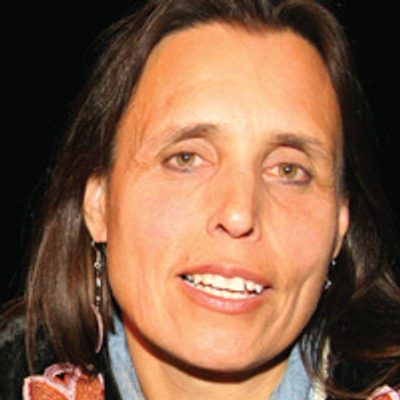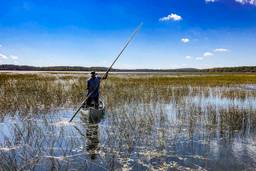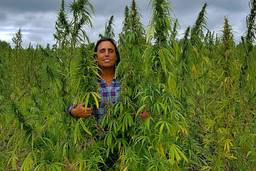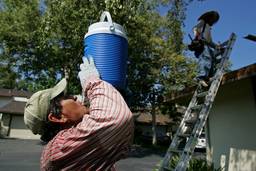
“You have an unmotivated person and you become more unmotivated on cannabis. I am afraid that the self esteem of our people is not going to handle legalizing it well.”
—Kevin Shore, White Earth tribal member, Gulf War Veteran using VHA prescribed medical marijuana for his chronic condition.
“I think that decriminalizing recreational use would benefit our people greatly since so many of us use it and many have been incarcerated for possessing it.”
—Martin Reinhardt, Professor of Native American Studies at Northern Michigan University, Marquette, Michigan.
It’s time to reconsider the regulation of marijuana and hemp on reservations. One year ago in October, the Department of Justice released a memorandum stating that federal authorities would no longer prosecute for marijuana on tribal land — even when it is illegal in the surrounding state. In that memo Justice Department Director Monty Wilkinson wrote that “in the event that sovereign Indian Nations seek to legalize the cultivation or use of marijuana in Indian Country,” United States Attorneys will essentially treat its legalization in the same way that the department does in states like Colorado and Washington, where the drug is legal, as long as reservations meet the same guidelines.
Over the last 12 months, tribes from California to New York have legalized the drug.
The Pinoleville Pomo tribe, which is located in Mendocino County in northern California, one of the largest marijuana growing counties in the country, began the first ever tribal marijuana grow operation. But in September, Mendocino County sheriff’s deputies raided the reservation, destroying nearly all 400 of the tribe’s plants. According to the sheriff’s department, the tribe was in violation of Mendocino County’s limit of 25 plants per lot. But tribal leaders claim, “The sheriff overstepped his authority.”
In a separate case, the Menominee Nation in Wisconsin legalized the growing of industrial hemp, under provisions of the 2014 Farm Bill. The low THC, non-psychotropic hemp plot was intended to be grown for research purposes. Acting U.S. Attorney Gregory Haanstad told the Associated Press that agents “executed federal search warrants on a large unlawful marijuana grow operation on tribal land and seized what agents described as approximately 30,000 plants weighting a total of several thousand pounds.” Some of the basis for this raid was that non-Menominee individuals were involved in the operation. Menominee Chairman Gary Besaw has stated the tribe will continue to work on the resolution to this issue.
According to News from Indian Country, the Omaha tribe of Nebraska has voted to look into getting into the marijuana businesses and the Seneca Nation of New York has approved a medical marijuana measure.
Lance Morgan (Winnebago), a tribal law expert in Nebraska, has stated that the Justice department memo on the marijuana and hemp legalization does not actually allow tribes to legalize marijuana. Rather it allows them to work with U.S. attorneys. And Morgan says U.S. attorneys in many states have been unwilling to let tribes move forward.
The fact is that legalization on American Indian reservations has become a sticky issue. The memorandum leaves a lot of grey area, especially in the 27 states which have not yet legalized marijuana in some form. Attorney General Cole, for instance, states that the Department of Justice will retain the right to prosecute individuals who engage in the distribution of marijuana to minors, and where revenue is going to criminal enterprises, driving under the influence or diversion to a state where it is not legal.
While some tribes are looking to this as a highly lucrative business, others are considering the potential challenges of participating in the pot industry.
The economics of pot
I am told that 40 percent of my White Earth tribe smokes the herb. The fact is we’re spending millions of dollars annually importing marijuana from largely unsavory characters onto the reservation at a great loss to our tribal economy. I haven’t done complete studies, but, conservatively, $60,000 a week is draining from the pockets of my fellow tribe members into the hands of outside dealers, most operating in the Twin Cities. With a little math, it looks like around $3 million annually is leaving the reservation for marijuana purchases. That is coming out of tribal pockets — pockets in some of the poorest counties in the state. That is part of our challenge. Could tribes curb that economic drain with a local marijuana economy?
Tribal communities would be unable, under the present regulatory scheme, to sell marijuana off reservation unless the state they find themselves in a state that has legalized marijuana. This is the case of the Pineoville Pomo in California, and tribes in states with medical or recreational use. When the state of Minnesota held its informational meeting on a new medical marijuana policy, regulatory officials stated that tribal sovereignty would dictate growing in that state, but there’s been no word on distribution or sales off reservation. The question of a local tribal economy in marijuana, however, is worth some consideration.
Drug wars
Marijuana has accounted for nearly half of all total drug arrests in the United States for the past 20 years, according to the FBI’s crime statistics.
Washington state data indicates that in 2010, arrests were three times that of two decades before. The majority of those arrested were white, but Natives were arrested at a rate of l.6 times higher than that of whites. The possession arrests, according to a study, cost Washington State (where recreational use is now legal) about $200 million between 2000 and 2010. That’s expensive.
A marijuana possession arrest creates a permanent criminal record easily found on the Internet by employers, landlords, schools, credit agencies, licensing boards, and banks.
Since 2007, around 80,000 people have lost their lives as a result of the fighting between drug cartels and Mexico’s armed forces, according to Reuters. And the Department of Justice reports that a large portion of the U.S. illegal drug market is controlled directly by Mexican cartels.
In 2012, a study by the Mexican Competitiveness Institute found that U.S. state legalization would cut into cartel business and take over about 30 percent of their market. Retired DEA officer Terry Nelson told Vice that legalization has affected drug trafficking and cartels. “The cartels are criminal organizations that were making as much as 35-40 percent of their income from marijuana,” says Nelson. “They aren’t able to move as much cannabis inside the U.S. now.”
Minnesota’s Native Mob gang has historically been involved in marijuana, as well as a host of other drugs and weapons. While prosecutions landed many leaders of the Mob behind bars in recent years, it is not clear in a state like Minnesota what the effect of legalization would be on Native gang activity, but it is worth considering.
Addictions and more addictions on reservations
“When my mother met her second husband (my stepfather), he used to smoke it occasionally. Then he would watch something silly on TV and fall asleep. She didn’t want him to get caught with it, so she insisted he only drink. This was a really bad idea, since [alcohol] didn’t relieve his stress and made him angrier and more violent. He would start looking for something to focus his anger on as he got drunk, which would almost always be one of his stepchildren. While drunk, he lost all sense of how hard or long he would beat us. When he was high, I don’t think he ever hit us at all. The law as it stands has probably put many children and spouses in this position.” – Anonymous interview
That’s probably a snapshot of a lot of houses. I surveyed numerous people on the question of addictions and the impact of legalization and got many opinions. What we know is that our tribal communities suffer from epidemics of addictions. We alter our consciousness for many reasons — the pain of historic trauma, boredom, lack of cultural and community strength, and because we like it. The root causes of our drive need to be changed, and that will take long-term work and healing. We need solutions to our problems, and we all know that drinking a six-pack or smoking a bowl is not going to make life better, though it might help you forget for a few hours.
Frankly, it’s easier to get prescription drugs on the reservation and snort them up your nose than probably anywhere else in the country. Sam Moose, Commissioner of Health and Human Services for the Mille Lacs Indian Reservation in Minnesota talks about the epidemic which is claiming new victims on his reservation: babies born addicted to opiates, both prescription painkillers and illegal drugs like heroin. According to Moose, the reservation is one of the hardest hit communities in Minnesota. Twenty-eight percent of babies with Neonatal Abstinence Syndrome (NAS) in Minnesota are born to Native Americans, even though Native Americans make up only about 2 percent of the state’s population. In other words, American Indian newborns are 8.7 times more likely than white babies to be born with NAS. Add to that Fetal Alcohol Syndrome Disorder (FASD), and we’ve got a pretty dire situation for the next generation. What would marijuana do to this?
“As a researcher of FASD, and a now doctor of clinical psychology. … I truly believe, on a personal, community and societal level that legalizing marijuana will decrease rates of FASD expression within our communities,” Melissa Goracke, a White Earth doctor tells me. “Access to marijuana will decrease women’s use of alcohol during pregnancy, which is the most violent teratogen to brain development, which lasts a lifetime. It’s a start and it’s simplistic, but it’s something.”
That’s an interesting thought, but many people remain opposed to “transferring addictions.” At the same time, from my limited study, marijuana use is pretty prevalent on the reservations.
The highest risk for marijuana: The teenage boy
“It is extremely rare to see kids who are chronically using pot doing well in school,” Dr. Brett Nienaber, a family and emergency ward physician near Brainerd, Minnesota, tells me. “It might have to do with this neurotransmitter called dopamine. Dopamine is the neurotransmitter, which is associated with the rewards center of your brain. If you do something well, like get an A, or win a race, you get a good feeling and that stimulates the reward system. Marijuana use really stamps out the dopamine.”
A new medical study quantifies this. “This study suggests that even light to moderate recreational marijuana use can cause changes in brain anatomy,” says Carl Lupica, of the National Institute on Drug Abuse. “These observations are particularly interesting because previous studies have focused primarily on the brains of heavy marijuana smokers, and have largely ignored the brains of casual users.”
A team of scientists compared the size, shape, and density of the nucleus accumbens and the amygdala —brain regions that plays a central role in emotion and pleasure — in 20 marijuana users and 20 non-users. Each marijuana user was asked to estimate their drug consumption over a three-month period, including the number of days they smoked and the amount of the drug consumed each day. The scientists found that the more the marijuana users reported consuming, the greater the abnormalities in the nucleus accumbens and amygdala. The shape and density of both of these regions also differed between marijuana users and non-users.
Marijuana can also cause an early onset of schizophrenia in young men, who are genetically pre-disposed. “If normally you would have gotten [schizophrenia] at 25,” Dr. Nienaber says, “you will more likely get your first psychotic break at 13, which is a problem because the longer you have it the more debilitating it is. The problem is that schizophrenics and people who are predisposed to it are really drawn to drug abuse.”
Mental health benefits of marijuana
There’s clear evidence of the benefits of marijuana in the treatment and pain relief of glaucoma, fibromyalgia, epilepsy, rheumatoid arthritis, seizures, PTSD (remember we Indians have the highest per capita number of living veterans of any community) and a host of other medical conditions. My friend Kevin Shore suffers from Gulf War Syndrome, and he is struggling with a host of serious medical conditions.
“Actually they call it rheumatoid variant disease at the Veterans Health Administration (VHA), because, like in Vietnam, they don’t want to call it an Agent Orange syndrome,” Kevin says. “They tried putting me on morphine, oxycodone, all of that didn’t work well. I found that cannabis was the least harmful to my body as the side effects go.”
Because Kevin is being treated by the VHA, he cannot smoke marijuana, or take it in any form. So they provide him with dramnol, a synthetic form of marijuana. While medical studies indicate that marijuana is helpful in many cases, it is clearly not a panacea for all illnesses.
Marijuana is a medicine. Marijuana does not solve all problems. It does not cure everything. It is a plant and it is a medicine. As much as our community deals with drug abuse, everyone agrees there is a need to restore our relationship to our plant relatives in a respectful manner. Indigenous peoples know plants have spirit and power that need to be addressed with reverence.








